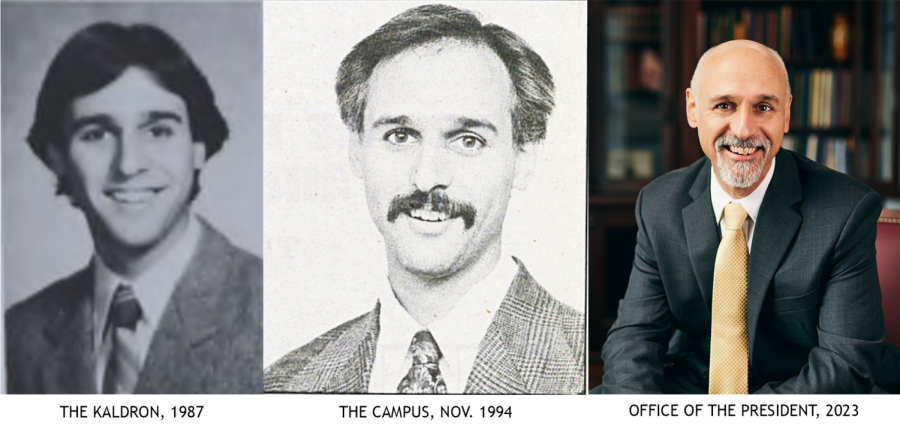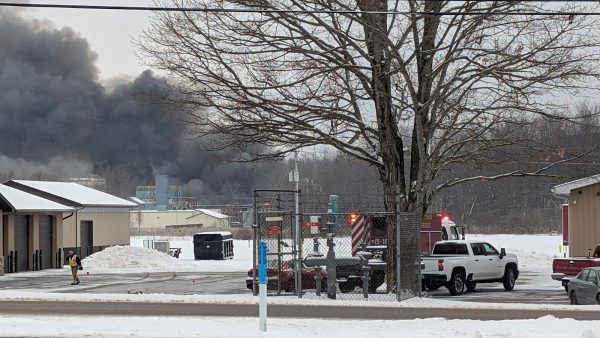A self-portrait of the president as a young man
From graduating in 1987 to joining the faculty in 1994 to serving seven years as provost and dean of the college to being appointed interim president in 2022, Cole has spent 34 of the 40 years since his matriculation at Allegheny College.
How did I end up sticking with Allegheny — both as a student and for many years afterward? That’s the question from Opinion Editor Sydney Emerson, ’23, that prompted me to write this reflection on my Allegheny journey. I first arrived at Allegheny as a student from a single-parent home in Brooklyn, NY. How did I end up sticking with Allegheny? I attribute that to purpose. Not my purpose, at least not early on, but the altruistic purpose of others who inspired in me a growth mindset, intellectual curiosity and the value of community. Allow me to share a few examples.
Early in my Allegheny journey I discovered the joy of being part of something larger than myself as a member of the Allegheny Civic Symphony. I had that opportunity because Tom Wood, an Allegheny music professor, believed in me as a first-year student and nurtured in me a love of music in a way that I hadn’t understood before — the way in which playing in an ensemble is something larger than oneself as part of the shared human experience; the way in which music crosses cultures and brings communities together. While I hadn’t planned on it, this led me to minor in Music, playing violin in the Civic Symphony and a baroque ensemble, opening for me a way of understanding the world that I hadn’t known before. Tom Wood had purpose.
Alongside my minor in music, as I pursued my major in geology, I found professors and mentors who cultivated in me a love of learning driven by curiosity and discovery. Imagine that, knowing for the sake of knowing. In this spirit, I’ve always been drawn to mountains — the contrast with the world around them inspires in me a wonder for how they form, which drew me into wanting to learn more, leading me to the study of geology. Did you know that the top of Mount Everest has layers of limestone that formed in a shallow ocean? It took the collision of India northward into Eurasia at the rate of a few centimeters per year to close that shallow ocean and push what was once the seafloor 29,032 feet into the atmosphere. Did you know that when Africa and North America collided during the formation of the supercontinent Pangea, there were mountains in eastern Pennsylvania that probably rivaled Everest? I remember the first time that Professor Wayne Brewer helped me and other students visualize this during a field trip — my world exploded into four dimensions — the dimensions of space plus time. Wayne Brewer had purpose. Then I wondered, where’d those mountains go?
Bob Dylan gives a clue in his song “Blowin’ in the Wind” when he asks in his croaky voice how many years a mountain exists before it’s washed to the sea. This was the basis for my senior project, Dylan-inspired, identifying mineral grains that were eroded from mountains and deposited in a small ocean to form sandstone that’s now exposed in the Hudson Valley region of New York — by knowing those minerals in the sandstone, one can piece together the mountains that were once uplifted and eroded. Like doing a puzzle, but without having the picture on the lid of the box. From this, with the contagious enthusiasm and mentoring of my comp advisor, Professor Bob Schwartz, I was able to reconstruct a facet of tectonic plate collisions that happened some 400 million years ago. Fascinating. And driven by tenacious curiosity. Bob Schwartz had purpose.
Now I’ll get a bit vulnerable and let you know that as a student, in my first term at Allegheny, I was not yet Alden Scholar material. It was also hard to pay for college. So after my first term, I returned to Brooklyn, got a job loading trucks at night, and reconsidered my future — wondering whether college was right for me.
After a few landline phone calls with Schwartz, my academic advisor, who somehow managed to get in touch with me — this was the 1980’s when cell phones and email were still things of the future — I returned for the second term with a spark of a growth mindset.
When I found my way back to campus, I was somehow contacted by Milosh Mamula, the director of financial aid, who helped me with a plan to continue paying for college. I also somehow got connected with Nancy Sheridan who was an academic support specialist — aka, an early version of the Maytum Center for Student Success that we have today. Soon after, I somehow became involved with community engagement and volunteered in Meadville. When I did poorly on an exam in my psychology class, Professor Mary Hudak somehow helped me understand how to learn from failure — the spark of growth mindset was getting brighter.
What I came to understand is that behind each of these “somehows” was someone whose sense of purpose was to serve — by guiding and supporting me and other students so that we could flourish and graduate with pride in what we accomplished. I have the wonderful vantage to see this same theme holding true today — whether in the classroom or lab, on the playing field, on the stage, or with any number of other learning experiences across campus.
Upon graduation, I more fully appreciated the value of my Allegheny education as I found myself superbly prepared for graduate school with research and communication skills, diverse perspectives, and the confidence in knowing how to learn. This foundation continued to serve me in my professional work in environmental consulting and then, full circle, as a faculty member at Allegheny in my teaching, scholarship and mentoring of students. These fundamental skills still serve me today, in a role that I certainly hadn’t imagined when I walked across the Commencement stage on Bentley lawn in 1987.
So, how did I wind up sticking with Allegheny? As a student, it was the unwavering purpose of faculty and staff that gave me support and inspired me to learn and grow. Now, years later, it is the unwavering purpose that has been ingrained in me for the success of Allegheny students throughout the arc of their experience. Looking back, I feel pretty good about what I gained from my Allegheny education, and today I remain absolute in my conviction for Allegheny.
Students, if I may offer a few words of advice — embrace your Allegheny education and trust that Allegheny faculty and staff are preparing you with purpose for success on paths that you may not even know exist yet.











Mary Vogan • Aug 7, 2023 at 11:25 am
Outstanding development of purpose, Ron,
I applaud you.